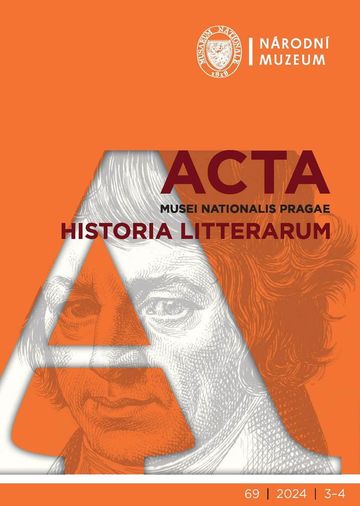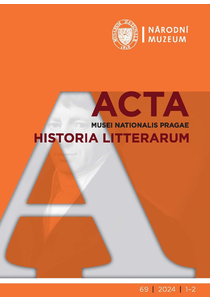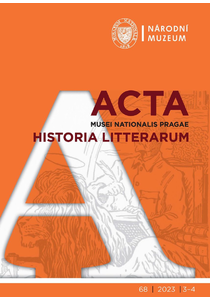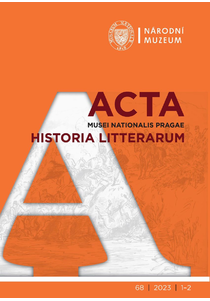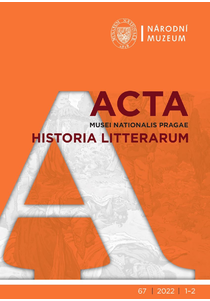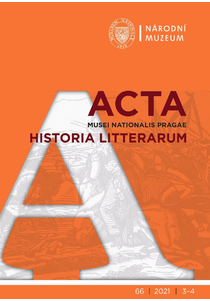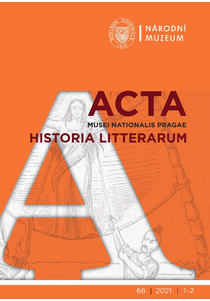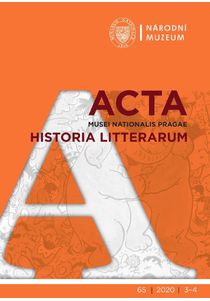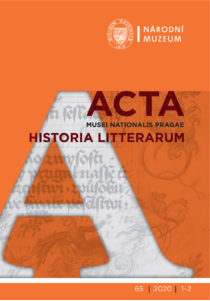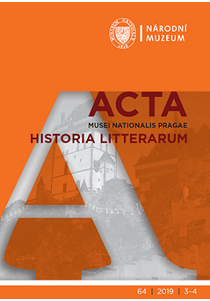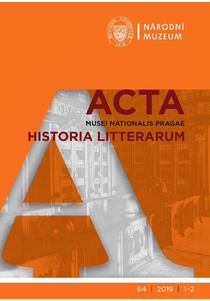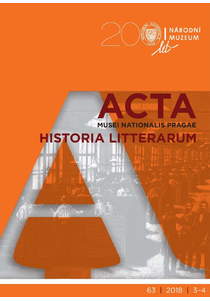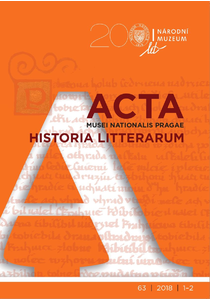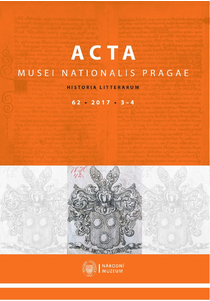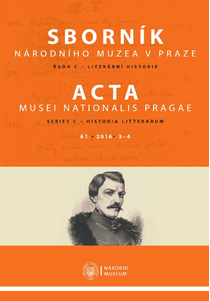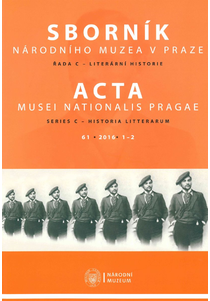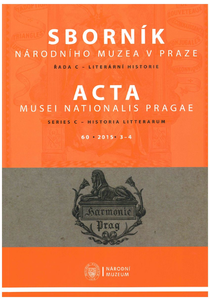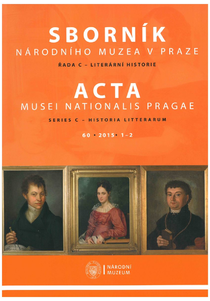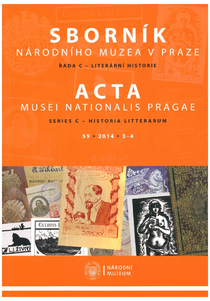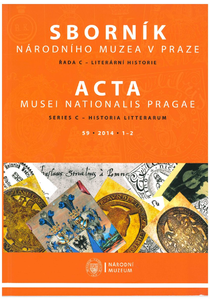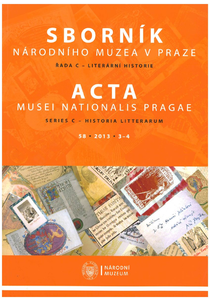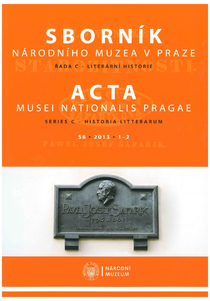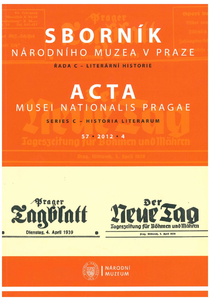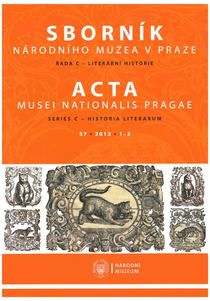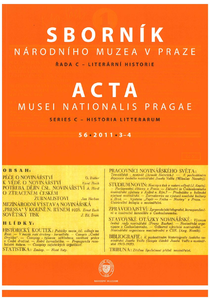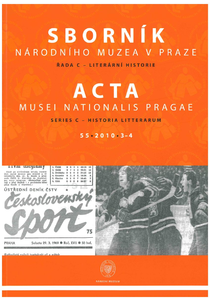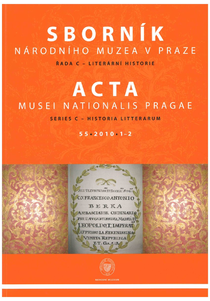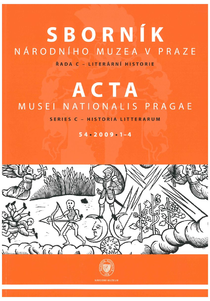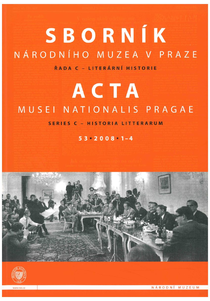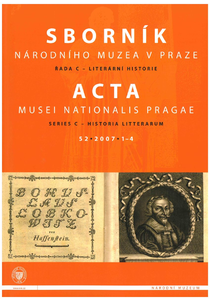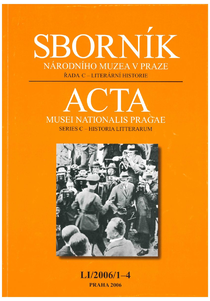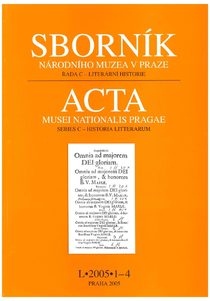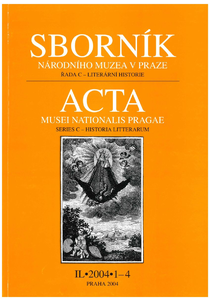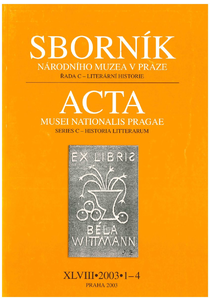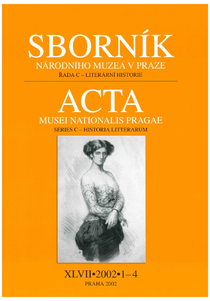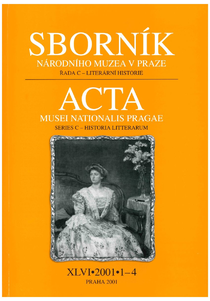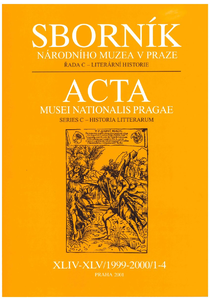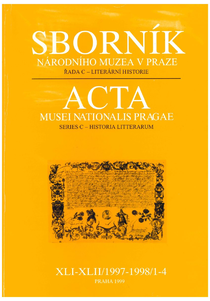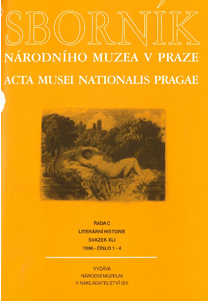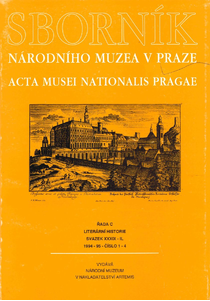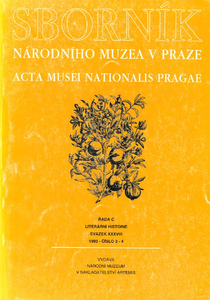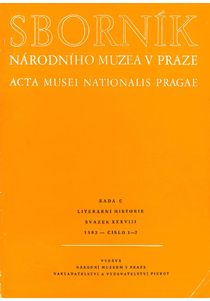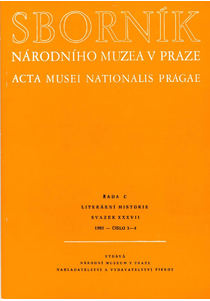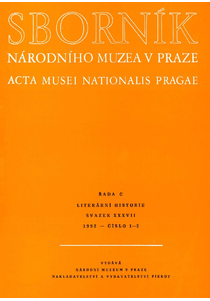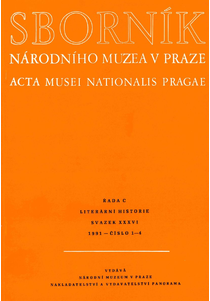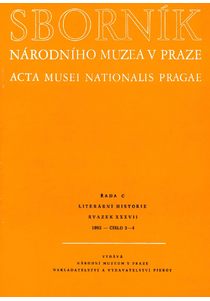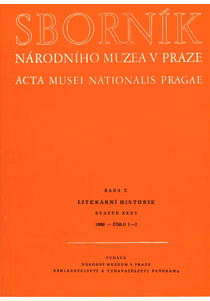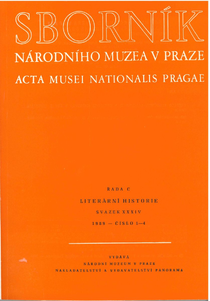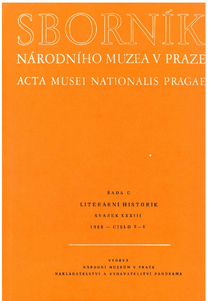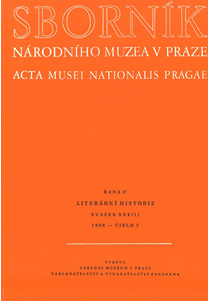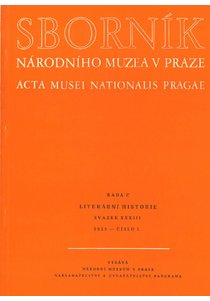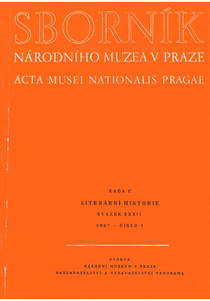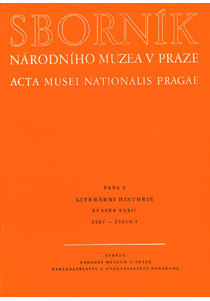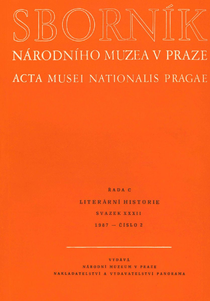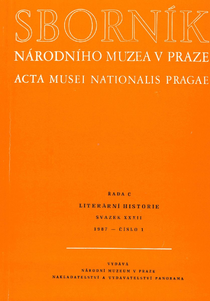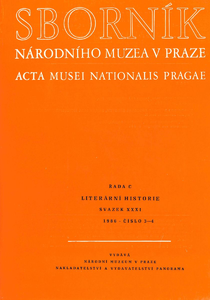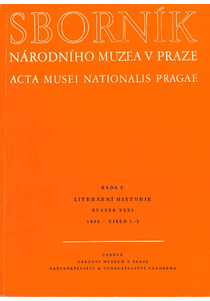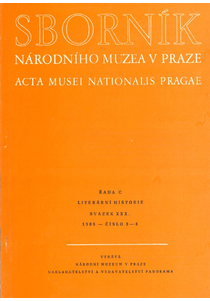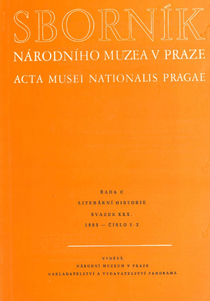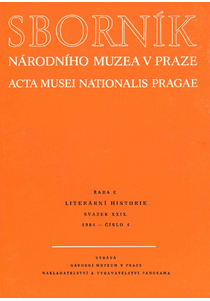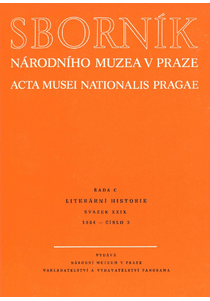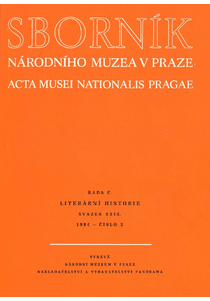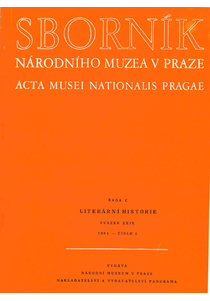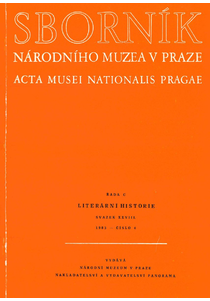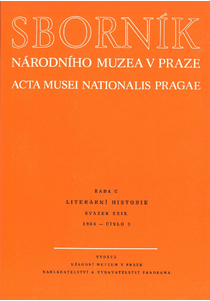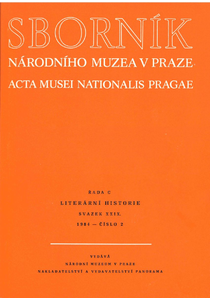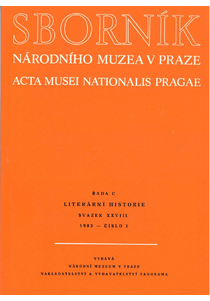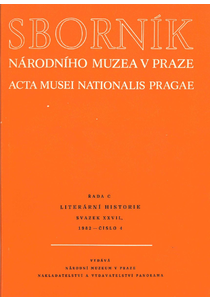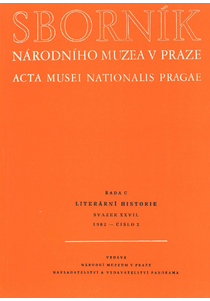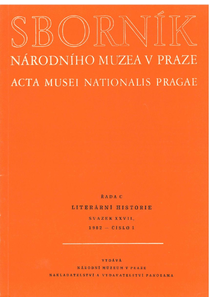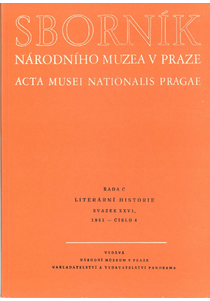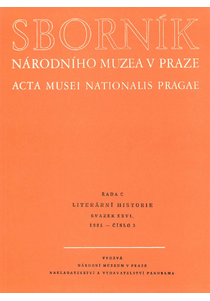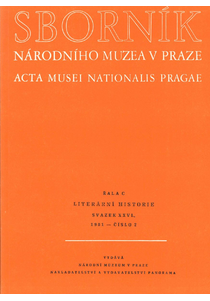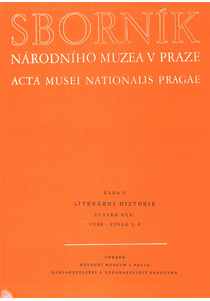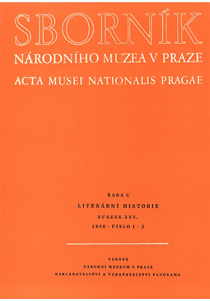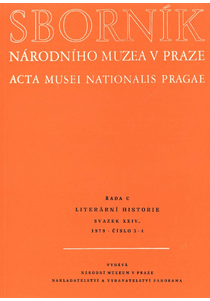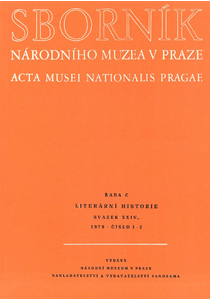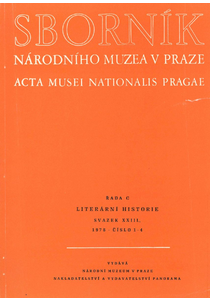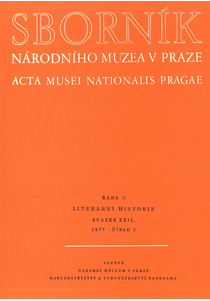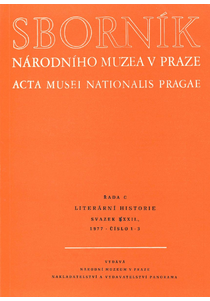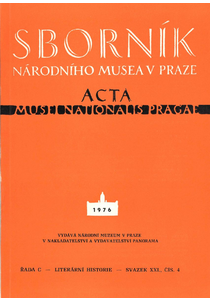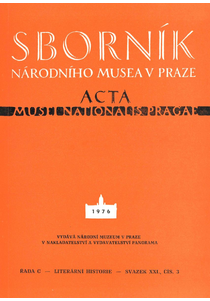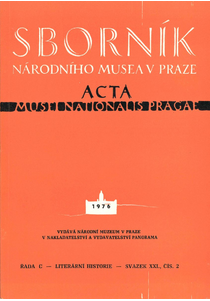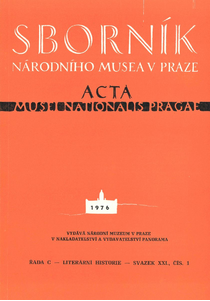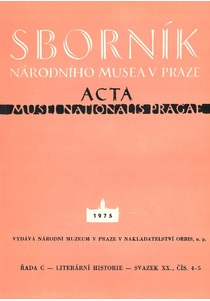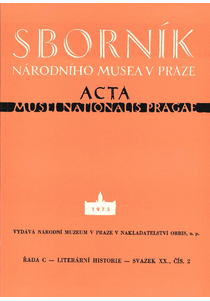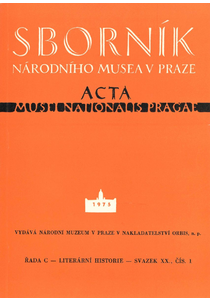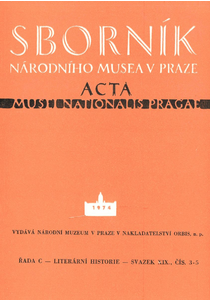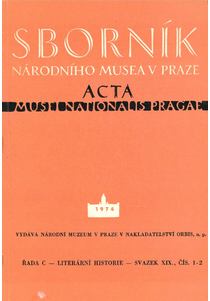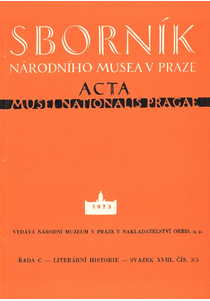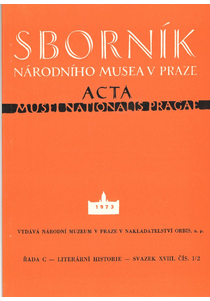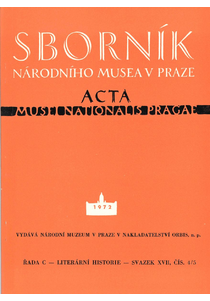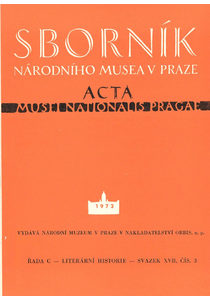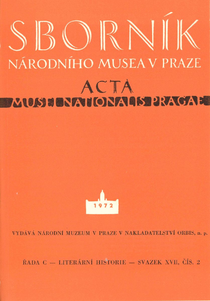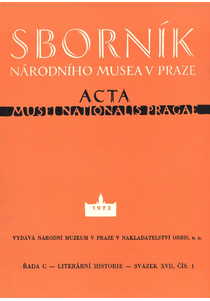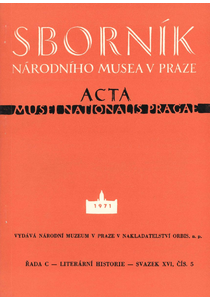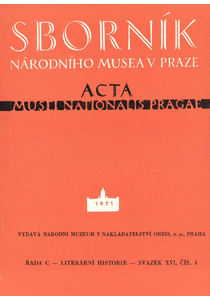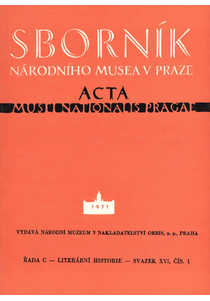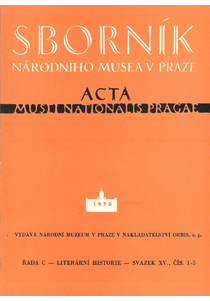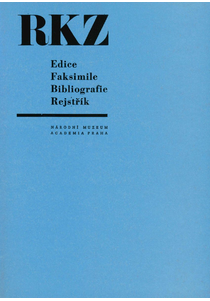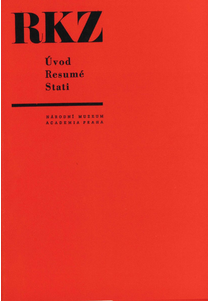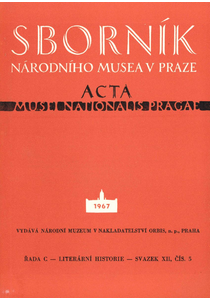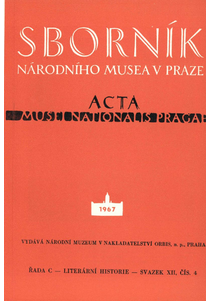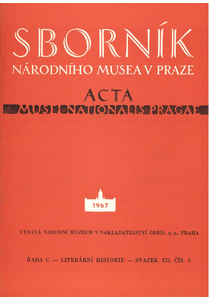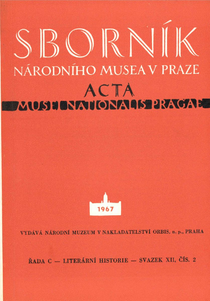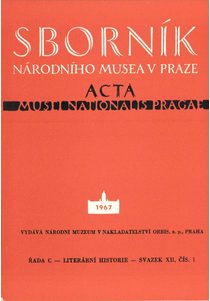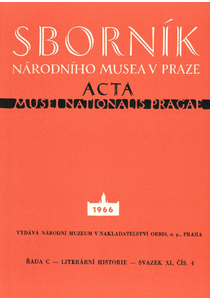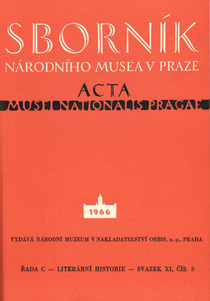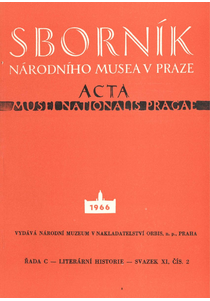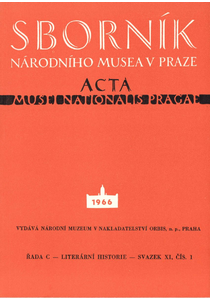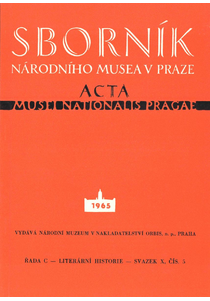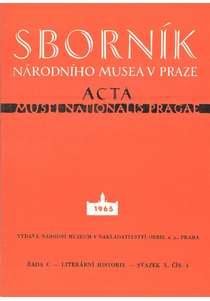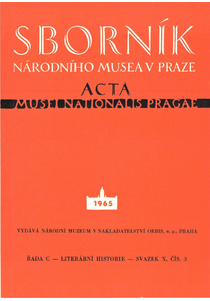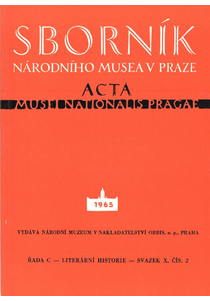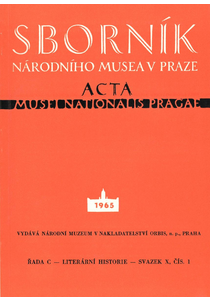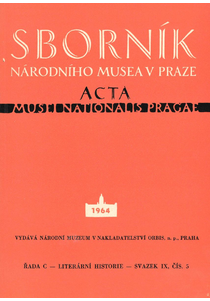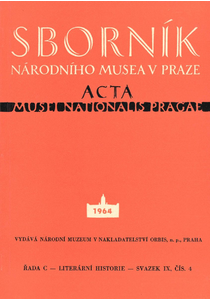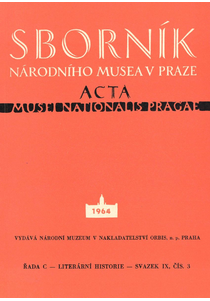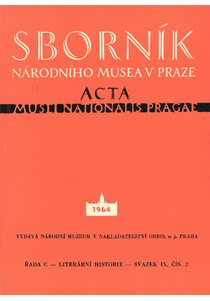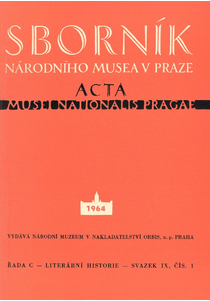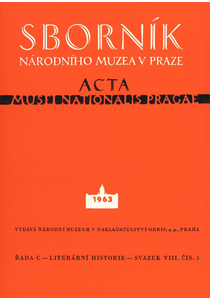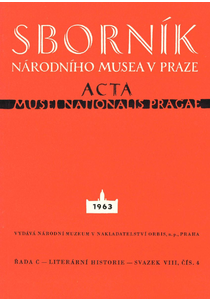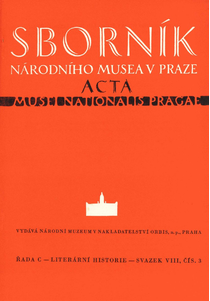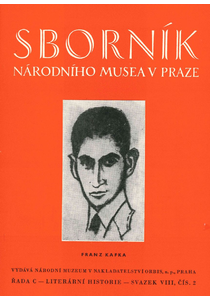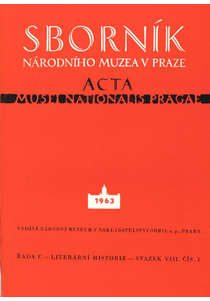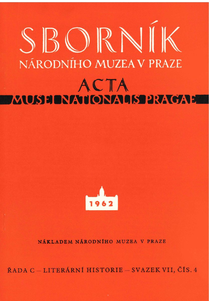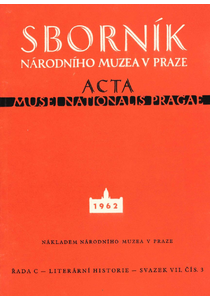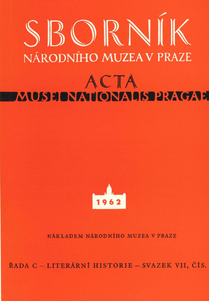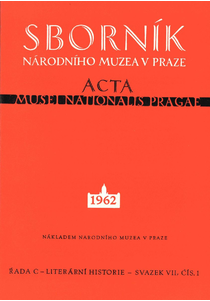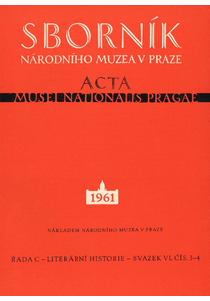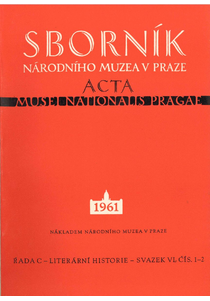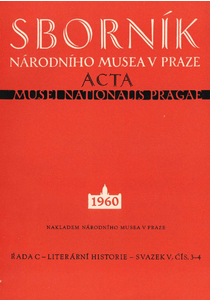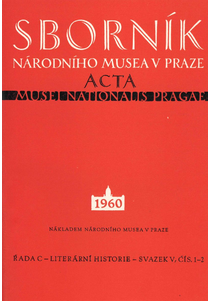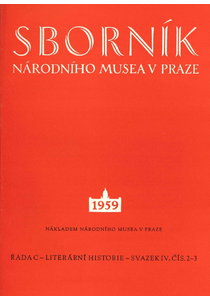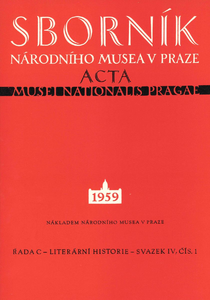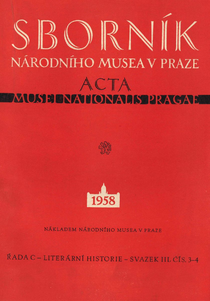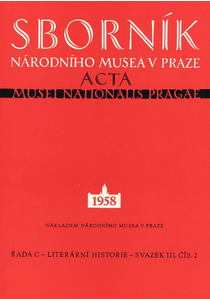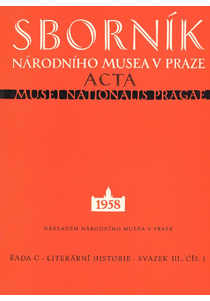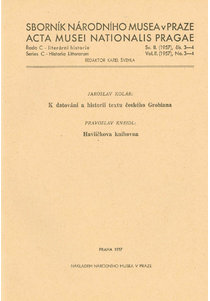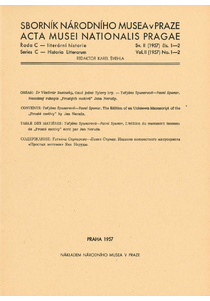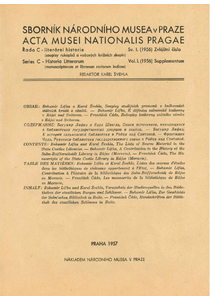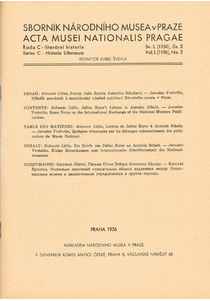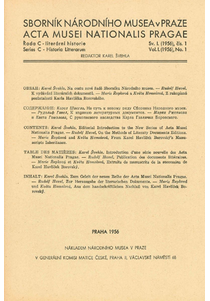Acta Musei Nationalis Pragae – Historia litterarum was established in 1956 as Sborník Národního muzea v Praze, řada C – literární historie (= Acta Musei Nationalis Pragae, series C – Historia litterarum. ISSN 0036-5351, until the volume 61/2016 inclusive).The journal is published twice a year as a double issue; the deadline of Nos. 1–2 is usually in November of the previous year, of Nos. 3–4 at the end of May. The journal publishes original scientific studies from the fields of book culture, library science and literary history, including such topics as the history of libraries and book sets, provenance research, the history of printing workshops and publishing houses, the history of selected periodicals, the issues of printed broadside ballads, illustrations, manuscript collections, and the history of bibliological research. Besides the studies, the journal also accepts reviews of relevant publications from the field and shorter material or methodological contributions (the Miscellanea/Materialia section). Since 2014, a regular part of the autumn double issue 3–4 has been the section Matiční listy, prepared by the association Matice česká, a part of the National Museum Society
Languages: Czech, English, German, Slovak. The articles in the Studies section have their title, abstract and keywords translated into English.
The Review Procedure
The editorial office of the journal Acta Musei Nationalis Pragae – Historia litterarum accepts contributions that correspond to the focus of the journal and have not been published elsewhere. After an article intended for the Studies section has been accepted, the text is assessed by the editor-in-chief in cooperation with members of the editorial board. In this phase, the article may be returned to the author to be complemented or reworked. Texts that do not correspond to the focus of the journal or the basic standards of scientific work or that are of a very poor language standard are not sent to the review process.
After an article has been accepted by the editorial office, it is sent for assessment to at least two independent reviewers; the review process is double-blind. The reviewers must not be members of the journal’s editorial board or work at the same workplace as the author. In the case of studies published within grants, it is not desirable that a reviewer be involved in the grant in any way. Before the text is sent to the reviewers, it is anonymised; the reviewers fill in the appropriate review form provided by the editorial office. The review procedure usually takes 4–6 weeks; in exceptional cases, however, a reviewer may request more time. In the case of two conflicting opinions, the editorial office requests a third review. Subsequently, the author receives all reviews together with other editing suggestions made by the reviewers or the editor-in-chief. In agreement with the editor-in-chief, the author is given adequate time to prepare the final version of the text. The articles that do not take into account the relevant comments of the reviewers and the editorial board cannot be published in the journal.
The texts sent to the sections Reviews, Miscellanea/Materialia, The News from the National Museum Library and Matiční listy undergoes the review process. Decisions on the publication of this type of texts are made by the editor-in-chief in cooperation with the editorial board (in the case of Matiční listy with selected members of the committee of Matice česká), or with another invited expert according to the topic of the article.
The final form of the respective issue is decided by the editor-in-chief in cooperation with the editorial board.
The Proofreading of Articles Accepted for Publication
After the editorial board receives the final version of the paper from the author, the text goes through the final editorial reading and then language proofreading. The author is informed by the editorial office of any other changes in his/her text, with the exception of elementary spelling and stylistic issues. The typeset article is sent to the author for proofreading, for which 7–10 days are usually reserved. The corrections are either made by the author electronically in the sent PDF using the correction functions designated for that purpose, or the corrected version is brought by the author in person or sent in paper form, in which case it is desirable to use common proofreading marks. The proofreading should only involve minor formal and factual corrections, not substantial changes in the structure of the text and the accompanying images that might affect the layout of the typeset document. The author’s proofreading is usually followed by 2–3 rounds of editorial proofreading. After the respective issue is published, the author receives two copies of the journal and the pre-print PDF of his/her article including the title page, contents and imprint.
Duties of the Authors
The authors can only submit texts that are the results of their original scientific research and in which their own research contribution is evident. The authors must cite the sources and references used correctly and completely. The text submitted to the editorial office of the journal Acta Musei Nationalis Pragae – Historia litterarum must not be simultaneously offered for review in another periodical. The authors are obliged to cooperate with the editorial office throughout the review process and the subsequent editorial work until the journal is sent for printing.
Duties of the Reviewers
The reviewers undertake to approach the assessed article as objectively as possible; if the addressed reviewer does not feel competent enough to assess the submitted text, he/she must inform the editor-in-chief of this fact. The reviewers evaluate the originality and the research contribution of the submitted study, the author’s work with sources and literature, and the stylistic and linguistic level of the text. Any objections should be duly substantiated and supported by relevant arguments or references to relevant literature. If the reviewers know that the text under review or its part has already been published or has been submitted for review in another periodical, they are obliged to inform the editor-in-chief of this fact. Likewise, the reviewers must inform the editorial office in the case of an imminent conflict of interest in relation to the text under review. The entire course of the review process in all its aspects is considered to be confidential.
The Text
Text Submission and Other Requirements
Send the text electronically in the .doc or .docx formats. Provide the text with the English title of the article, an English abstract in the length not exceeding 1,200 characters including spaces and five keywords in English.
Formatting and Fonts
Use the type Times New Roman (Unicode), size 12, spacing 1.5. Write the title of the article in the type Times New Roman (Unicode), size 14, bold. After the title, you can attach a reference to a grant or project by means of the symbol *.
Citation Method
For footnotes, use the respective automatic function in Microsoft Word – the notes must be placed at the bottom of the page on which the reference appears, not at the end of the article.
Citations in the footnotes should be abbreviated using the short-title system (e.g. MAŠEK 2015, pp. 1–2), separate more references by a semicolon (MAŠEK 2024, pp. 1–2; ŠÍPEK 2024, pp. 5–7). Otherwise, the footnotes are primary intended for an additional explanation or a commentary on the main text.
The end of the article must contain “The Bibliography”, which can be divided into “Primary Sources” and “Secondary Works”.
The Bibliography must be followed by the basic information about the author in this format:
First name and surname
The author’s workplace (affiliation to an institution)
Address
Bibliography Citation Rules
The literature is cited in accordance with the applicable standard – ČSN ISO 690:2011. For more information, see ČSN ISO 690:2011 and http://www.evskp.cz/SD/4c.pdf. In bibliographic records, use only these abbreviations: (ed.) = editor, (edd.) = editors, (trad.) = translation. The authors are listed alphabetically. More articles by the same author are organized chronologically in ascending order. More articles by the same author from the same year are distinguished by letters after the year.
MAŠEK 2013: MAŠEK, Petr. …
MAŠEK 2014: MAŠEK, Petr. …
MAŠEK 2015a: MAŠEK, Petr. …
MAŠEK 2015b: MAŠEK, Petr. …
Citations of monographs:
SURNAME, First Name. The Title of the Publication. The Place: The Publisher, the year. (The Edition, the number of the edition if applicable.)
ČAJKA 2011: ČAJKA, František. Církevněslovanská legenda o sv. Anastázii. Praha: Slovanský ústav AV ČR, 2011.
ČAJKA – ČERNÝ 2016: ČAJKA, František – ČERNÝ, Marcel (edd.). Slovník jazyka staroslověnského – historie, osobnosti, perspektivy. Praha: Slovanský ústav AV ČR, v. v. i., 2016.
BLÁHOVÁ 1973: BLÁHOVÁ, Emilie. Nejstarší staroslověnské homilie (syntax a lexikon). Praha: Academia, 1973. Studie ČSAV; č. 11/1973.
Citations of the editions of earlier literature:
SURNAME, First Name (ed.). SURNAME, First Name. Publication. The Place: The Publisher, the year.
DOBROVSKÝ 1963: HEŘMAN, Miroslav (ed.). DOBROVSKÝ, Josef. Spisy a projevy. Českých přísloví sbírka. Praha: Nakladatelství ČSAV, 1963.
Citations of monograph chapters:
SURNAME, First Name. The Title of the Article. In: SURNAME, First Name (ed.). The Title of the Publication. The Place: The Publisher, the year, pages.
JOHNOVÁ 2008: JOHNOVÁ, Radka. Segmentace firem a organizací. In: Marketing kulturního dědictví a umění. Praha: Grada, 2008, pp. 85–87.
Citations of articles in anthologies:
SURNAME, First Name. The Title of the Article. In: SURNAME, First Name (ed.). The Title of the Anthology. The Place: The Publisher, the year, pages.
HORÁLEK 1948: HORÁLEK, Karel. K otázce lexikálních bohemismů v staroslověnských památkách. In: Slovanské studie. Praha: Nakladatelství Vyšehrad, 1948, pp. 115–119.
Citations of studies in journals:
SURNAME, First Name. The Title of the Article. The Title of the Journal the volume, the year, the number of the issue, pages.
TŘEŠTÍK 1984: TŘEŠTÍK, Dušan. Diskuze k předloze václavské legendy Laurentia z Monte Cassina. Listy filologické 107, 1984, No. 2, pp. 85–89.
GRAUS 1966: GRAUS, František. Slovanská liturgie a písemnictví v Čechách. Československý časopis historický 14, 1966, pp. 479–495.
Citations of diploma and dissertation theses:
SURNAME, First Name. The Title. The place and year of writing. The type of thesis. The name of the school.
KAVÁLKOVÁ 2009: KAVÁLKOVÁ, Monika. Analýza vybraných kapitol staroslověnského překladu Gumpoldovy legendy. Olomouc 2009. A diploma thesis. Univerzita Palackého v Olomouci. Filozofická fakulta.
Citations of electronic sources:
Manuscriptorium – Digital Library of Written Cultural Heritage [online]. Národní knihovna České republiky. [retrieved on 17 Jan 2017]. Accessible at: http://manuscriptorium.com
Vokabulář webový [online]. Version 0.8.0. Oddělení vývoje jazyka Ústavu pro jazyk český AV ČR, v. v. i. [retrieved on 17 Jan 2017]. Accessible at: https://vokabular.ujc.cas.cz
Citations of primary sources:
Manuscripts:
Title, institution, shelf mark, folio.
Liber viaticus Jana ze Středy, Národní muzeum, Knihovna národního muzea, shelf mark XIII A 12, fol. 69v.
Early printed books:
SURNAME, First Name. The Title. The Place: The Printer, the year. The page. The Bibliography + the number of the issue.
HABERMANN, Johann. Vita Christi: Život a celá Evangelistská Historia o Pánu Ježíši Kristu. Praha: Michael Peterle, 1579. Knihopis No. 2835.
Archival sources:
The name of the institution, the mark/name of the collection, the inventory number or shelf mark, the number of the box/book/folder/file, which can be complemented by the date and place of issue of the documents, the name of the official books and their time range, in the case of more extensive materials also the page number.
Archiv města Brna, collection A 1/3 Archiv města Brna – Sbírka rukopisů a úředních knih, MS 3, fols. 1r–2v.
Review and Reports
The section of reviews and reports, like the studies, follows the citation standard ČSN ISO 690:2011, but it does not use abbreviated citations referring to the Bibliography.
Ilustrations
Copyright
The author is responsible for securing copyright and reproduction rights to his/her pictorial supplements for both printed and electronic publications.
The Format of the Pictorial Supplement
Send your pictorial supplement in the resolution of at least 300 dpi in the jpg, jpeg or tiff format. Each figure must be numbered and provided with the basic description. Place the respective number of the figure in the text of the article where (at least approximately) you want the figure to appear in the typeset text.

